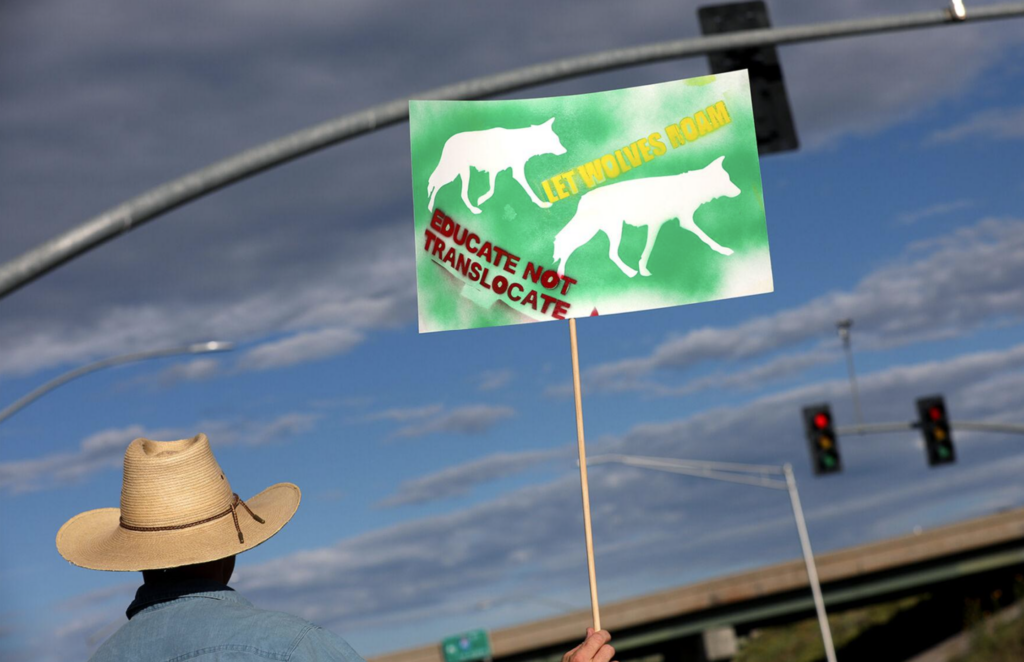Protesters argue wolves stay put
Concerns raised over moving pack south of I-40 border

BY MAKAYLA O’BANNON, Sun Staff Reporter
Makayla O’Bannon can be reached at makayla.obannon@azdailysun.com.
Originally published on August 13, 2024 in the Arizona Daily Sun: https://azdailysun.com/news/local/hope-for-wolves-rally-voices-concerns-about-proposed-mexican-wolf-pack-relocation-at-little-america/article_f7ccc1ea-58d1-11ef-8e61-77857b95474a.html
Protesters from environmental organizations and the community gathered outside Little America Hotel on Friday morning with banners, flags, and a wolf costume to voice their dissent to the Arizona Game and Fish Commission (AZGFC) about the proposed removal of a Mexican gray wolf pack north of the Interstate 40 border.
The Kendrick Peak wolf pack is currently roaming the Kaibab National Forest near Grand Canyon National Park, about 50 miles from where several agencies within the U.S. Congress and the U.S. Fish and Wildlife Service (FWS) have allowed Mexican gray wolves to prowl.
According to AZGFC Mexican wolf coordinator Jim DeVos, relocation and recovery of Mexican wolves is managed by a team comprised of staff from the Bureau of Land Management, the National Park Service and the U.S. Forest Service. Since the wolves live within Arizona and New Mexico, the federal agencies have allowed the state’s game and fish departments to have a “cooperator status” for their recovery.
This means the AZGFC does have some authority on the recovery of the wolves, but ultimately, the FWS has the final say on whether wolves are relocated.
“Any decision on movement of a Mexican wolf outside of historical range is based on broad discussions amongst key agencies and not a single agency making this decision,” DeVos said in an email. ”What agency that actually moves a Mexican wolf depends on location and staffing availability, but again, is not a unilateral decision.”
The pack is set to be transferred to southeastern Arizona, where the other estimated 257 wolves from their species reside.
The organization of the rally came together in less than two days when Grand Canyon Wolf Recovery Project Executive Director Claire Musser and Greta Anderson, deputy director of the Western Watershed Program, heard that the AZGFC would be moving the location of their meeting to Little America.
Turnout for the rally was 11 people at its busiest. From that group, six people, including Musser and Anderson, filled out cards for public comments. The commission allowed three minutes per person to speak, but none of the ralliers spoke for more than two.
“Wolves are not voiceless; they are showing us what they need, and it’s time we start listening,” Musser said during her public comment. “I’m asking you on behalf of the wolves to leave the Kendrick Peak pack free to live their lives in peace. After all, their lives are just as important to them as mine are to me.”
The rally was a part of a larger movement to educate the public and abolish the wolf border, which was put in place to sequester the wolves south of the I-40.
“It is equally tragic and absurd that the agencies in charge of recovering wolves are arbitrarily removing them for what are ultimately political purposes,” said Taylor McKinnon, Southwest director of the Center for Biological Diversity.
“Arbitrary” was the word chosen to describe the I-40 boundary by McKinnon, Musser, Anderson and other supporters. Anderson said the wolves, as a result of climate change, have decided to move northward for better chances at survival.
Yet the AZGFC said the boundary is much more solidified.
“This definition is not arbitrary, but, as I said, is based on many different scientific studies,” DeVos said.
The historical range of the Mexican wolves is what dictates where the wolves can reside, he said. This range was dictated by the FWS based on “different scientific publications by pre-eminent scientists with the literature dating back almost a century,” he said.
The Endangered Species Act explains that recovery for endangered species, including Mexican wolves, needs to happen within the historical range. So, the proposal of the relocation of the Kendrick Peak pack would put them back in the historical range decided by the FWS and others.
The pressure to stop the relocation of Mexican gray wolves south of the I-40 is not new. The most popular case about this is about Anubis.
Anubis was a Mexican gray wolf who had wandered north from the I-40 and was relocated back south. He ran north again and was mistakenly shot and killed. Since then, activists have used his name and story as an argument for the removal of the boundary.
“The reality is wolves live in the present, not their historical range, and they are facing an uncertain future with climate change,” Anderson said. “We’re seeing all kinds of animals disperse to more appropriate habitats, northward in higher elevation. So what I ask for the AZGFC is to instruct the department to also live in the present.”
Anderson and Musser do not have further plans for rallies or protests for the Mexican wolves. The plan is to go back to educating the public about the wolves and keep monitoring the Kendrick Peak pack’s movements.
As of now, the AZGFC will continue with its plan to relocate the Kendrick wolf pack south of the I-40.



